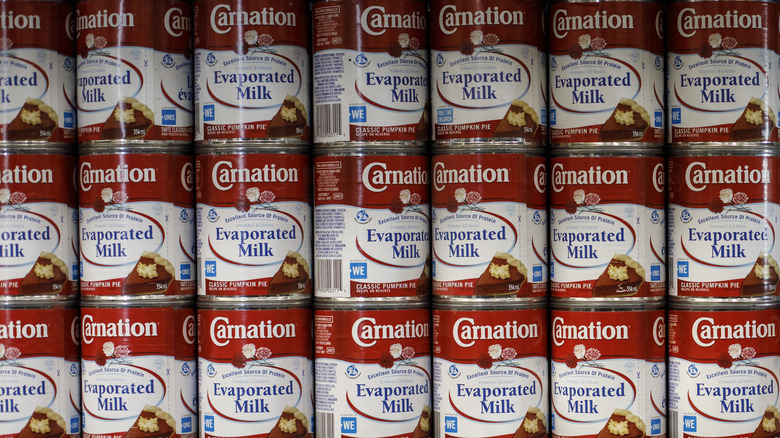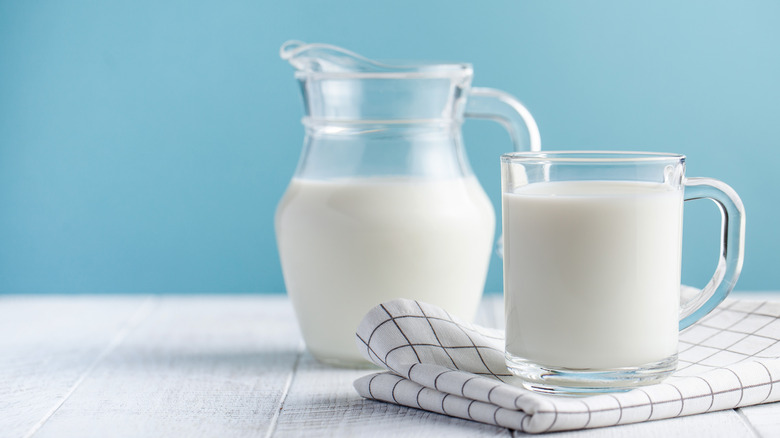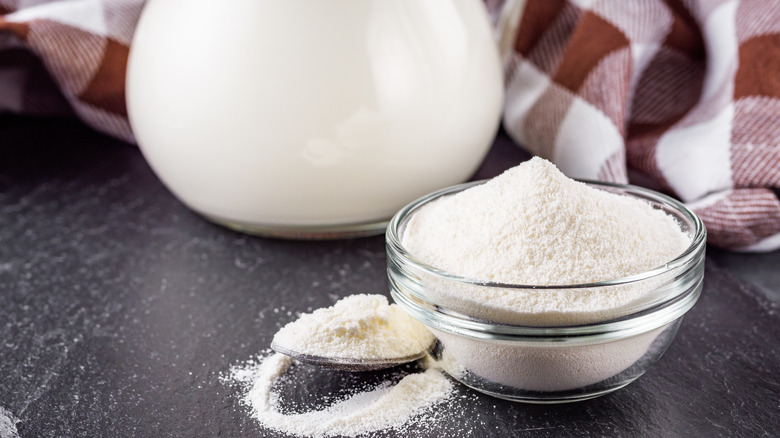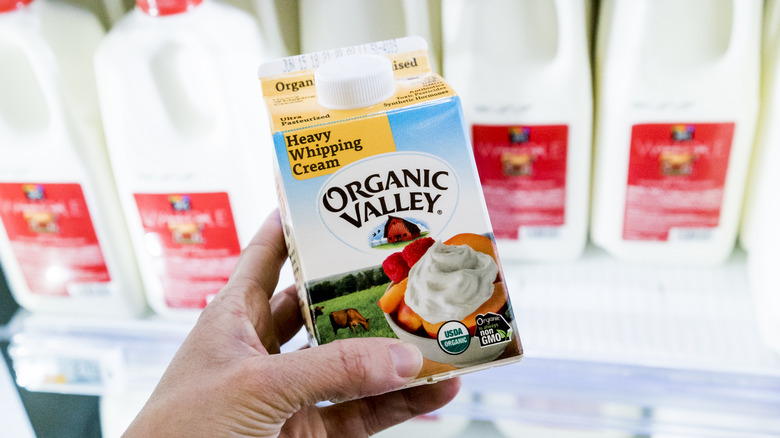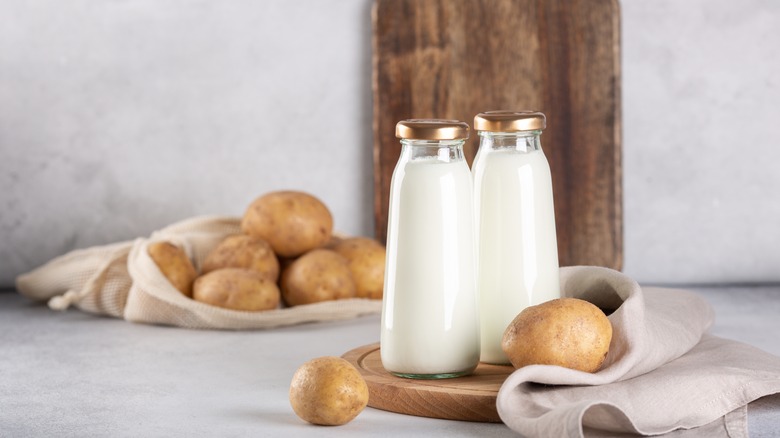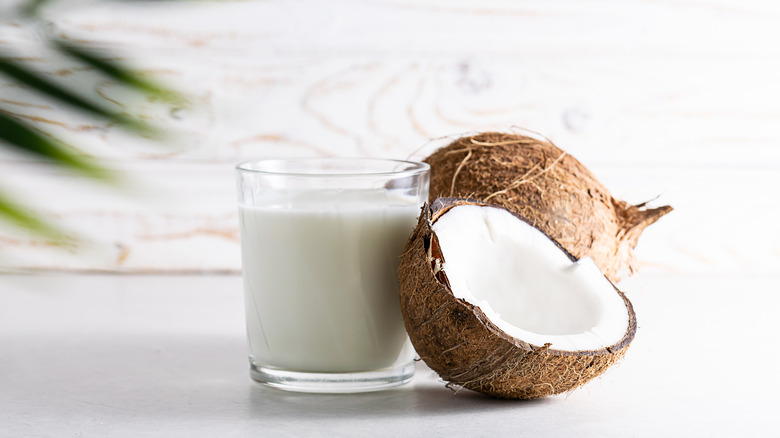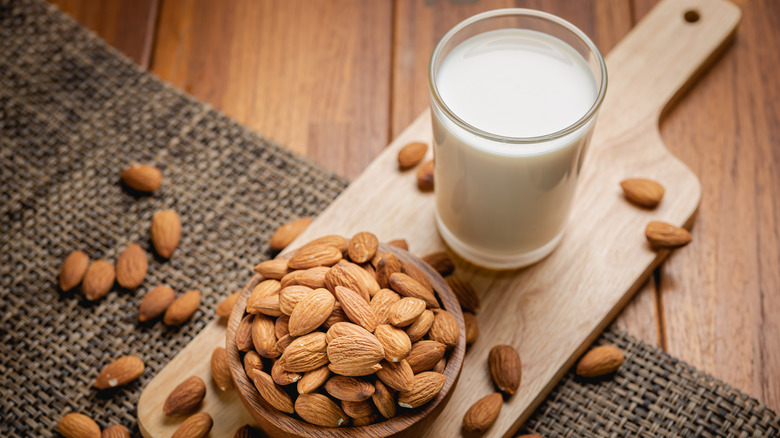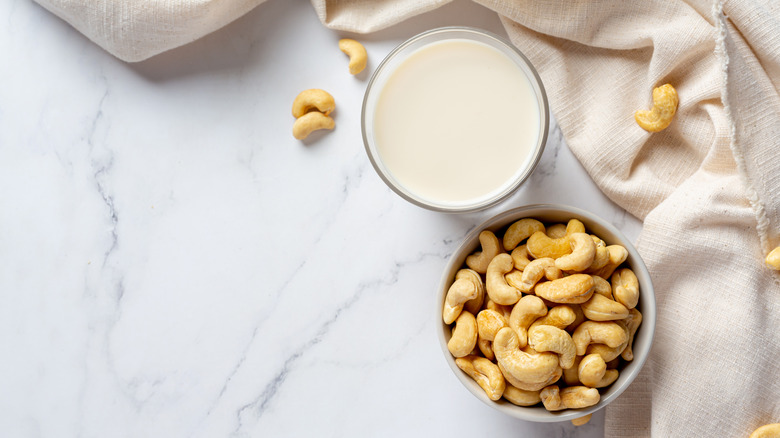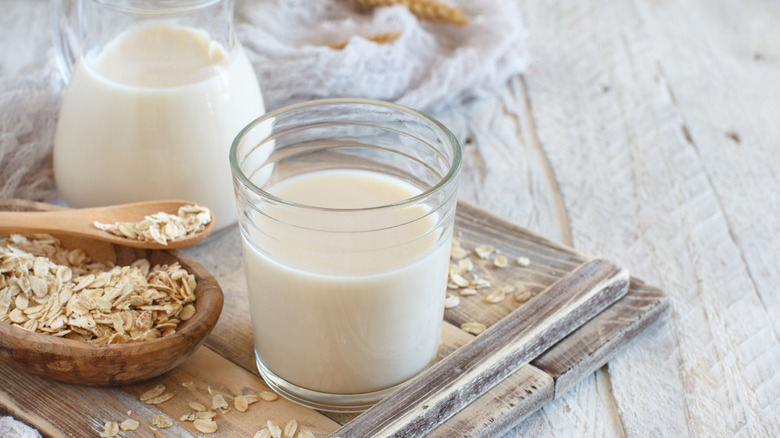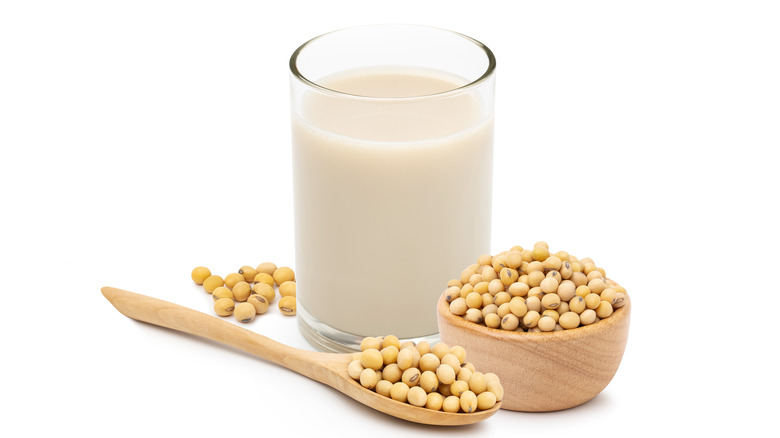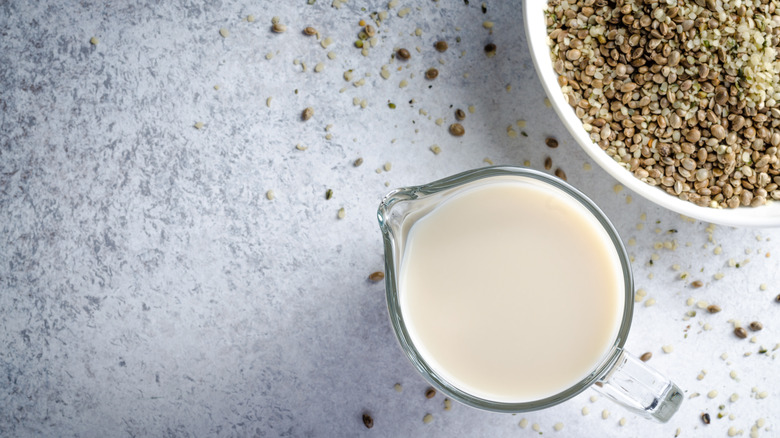The Absolute Best Evaporated Milk Substitutes
Go into your kitchen and open up a cupboard, and chances are you've got a can or two of evaporated milk stashed away. A conveniently shelf-stable dairy product, with the versatility for both sweet and savory recipes, evaporated milk has loads of benefits. An unopened can will last for around a year, but it likely won't sit around for that long. That's because it can be swapped in for other dairy ingredients (like regular milk) in recipes that could use a little added richness or creaminess. That's because evaporated milk starts as fresh milk before it's heated to evaporate about 60% of its water content. The result is a milk with a more concentrated flavor and a thicker texture, lending itself wonderfully to an array of desserts and savory dishes. Keep in that mind that though similar, there is a key difference between sweetened condensed milk and evaporated milk: The latter is not loaded with excess sugar.
Just like how you can use evaporated milk in place of fresh milk in many recipes, so too can evaporated milk be replaced with other alternatives. Whether you're looking to lighten the calories, use a plant-based milk that has more nutrients than regular milk, or you simply don't have a can in the cupboard, these are the best evaporated milk substitutes.
Fresh milk
The most common substitute for evaporated milk, as you might guess, is good old-fashioned fresh milk, which is the likeliest thing you'll have on hand in a pinch (via Bigger Bolder Baking). While you can't just swap it right in for evaporated milk at the same ratio, due to the textural difference and the fact that fresh milk simply has more water content, it's easy to get it recipe-ready by pouring it into a saucepan (use 60% more milk than the recipe calls for, since that's typically the amount reduced in evaporated milk cans), bringing it to a simmer, and cooking over low heat until it's reduced down.
Basically, it's DIY evaporated milk that you can make in a snap. Since the process resembles how evaporated milk is regularly made, it is the version that will most closely replicate the same flavor and texture you'd find from the canned version.
Powdered milk
A lot of the most sensible and convenient alternatives for canned evaporated milk is simply a matter of adjusting other ingredients you might already have in the fridge or the pantry. In this case, turning powdered milk into evaporated milk is the inverse of how you'd turn fresh milk into evaporated milk — rather than simmer to reduce and remove water, you just need to rehydrate powdered milk into evaporated milk by adding water.
Naturally, the amount of water differs from if you were just reconstituting it back into regular milk. So in this case, since you're looking for a milk that's denser, you'd add 60% of the amount of water you'd use to make milk in order to achieve the right evaporated milk (via My Frugal Home), resulting in a thicker product with the right taste and texture for your recipe. Since evaporated milk is simmered, it achieves a natural caramelized flavor, which you won't get by repurposing powdered milk, but the body will be spot-on.
Heavy cream
Relatively common ingredients like fresh milk and powdered milk are handy alternatives if you're just looking to replicate the perfect texture of evaporated milk. But sometimes you might want to enrich a recipe even further, and for that, you'd need to bump up the creaminess. If calorie count isn't a concern, look no further than heavy cream. Naturally thicker and creamier than evaporated milk, it's a surefire way to add a bit more decadence, especially to a dessert. Unlike fresh milk, you don't need to reduce heavy cream on the stovetop, since it's already inherently thick. Rather, you can just swap heavy cream for evaporated milk using the same ratio.
Of course, while the desired texture will be there, it helps to know that the end result will have more fat, and while it'll certainly be creamy and silky-smooth, it'll lack that tinge of caramelization. If you want to use cream, but don't want all that added thickness, you can also dilute it a bit by mixing in some fresh milk.
Half-and-half
One creamy and convenient alternative to evaporated milk is half-and-half, which many folks happen to have on hand for coffee purposes. This swap requires a simple 1-to-1 ratio, so if your recipe calls for a quarter cup of evaporated milk, you can just use a quarter cup of half-and-half, without any further preparation.
Another positive: There's no need to reduce or dilute half-and-half at all to achieve the consistency of evaporated milk since it's already thick enough on its own — this makes it an especially nifty go-to if you're strapped for time. While the milk and cream combo is a great swap from a textural standpoint, it has a more muted flavor than evaporated milk. Specifically, half-and-half lacks those cooked and caramelized notes, so if you're still looking for more of a pronounced evaporated milk taste, you may want to go with a different selection in the dairy aisle.
Potato milk
Although not yet widely available stateside, if you happen to be in Sweden, China, or the U.K., potato milk could be a unique option for you. Made from a patented emulsion of potatoes and rapeseed oil, potato milk also happens to be gluten-free, soy-free, and nut-free, making it a great option for those with allergies. The on-the-rise dairy-free alternative milk is currently only on the shelves in a select few countries (for now), but it's something you can try making at home (via Today).
It's thicker than most non-dairy milk products, but not as thick as evaporated milk, which means you'd need to reduce potato milk over a simmer to lower the water content a bit. Flavor-wise, while it's not slightly sweet or caramelized like evaporated milk, it's also not as potato-y as you might think. Rather, it's more in line with other plant-based options on the market.
Coconut milk
If altering the flavor of a dish typically made with evaporated milk is of no concern, then consider cooking with coconut milk instead. Like other richer alternatives, like half-and-half or heavy cream, coconut milk is texturally on the same page as evaporated milk, with a naturally creamy thickness that makes it easy to swap directly into any recipe (i.e. you don't need to simmer and reduce it). While the resulting texture will be a bullseye, the main thing to consider here is how prominent the coconut flavor will be.
Coconut milk by itself is unmistakably coconut-centric, and that flavor will carry through as an evaporated milk replacement, so be mindful of that when adding it to a recipe. Basically, if you're cooking or baking something where the flavor of coconut will fit, then go for it, but if you don't want your pumpkin pie to taste tropical, you might want to reconsider.
Almond milk
If you're looking for an evaporated milk substitute as a way to cut down on calories and/or add more nutrients to a recipe, nut milk alternatives are a winning solution. Much lower in calories than evaporated milk, they're a wholesome option for anyone looking to stick to a diet or make a recipe a tinge healthier. Almond milk in particular, with all the inherent health benefits of its namesake nut (via Healthline), like protein, calcium, and Vitamin E, is a great choice in this regard. However, since almond milk is thinner than evaporated milk, reduced down to about 50% by gently heating it in a pan on the stove for 30 minutes to an hour, before swapping it into a recipe (via Binky's Culinary Carnival).
Almond milk doesn't have the same caramelized flavor as evaporated milk, but it's similar in that it has a touch of sweetness to it, making it a particularly great evaporated milk substitute for desserts and baked goods.
Cashew milk
Loaded with protein and nutrients, including the ability to improve heart health, aid in weight control, and decrease cholesterol (via Very Well Fit), cashew milk comes with the added benefit of also being a bit thicker than other dairy-free milks, like the almond variety. Between its nutritional benefits and its texture, it's a good-for-you nut milk that can easily serve as a recipe understudy for evaporated milk.
Like most other milk options, dairy-free or otherwise, you'll still want to double the amount and reduce cashew milk over a slow simmer to take down the water content by about 50%, thus evaporating it enough to get the same desired consistency — silky-smooth, and slightly rich and creamy, so as to provide moisture for a recipe without making it too watery. More muted and versatile in flavor than other nut milks, cashew milk works well as an evaporated milk replacement in both sweet and savory applications, without offering any overpowering flavors.
Oat milk
If you'd prefer a non-dairy alternative that doesn't include nut milk (especially when allergies are involved) as your makeshift evaporated milk of choice, oat milk could be an ideal solution. One of the most popular plant-based milk options on the market these days, it's not only readily available in just about any store, but it's also much more nutritious and healthy than evaporated milk, not to mention lower in calories by a substantial margin.
Oat milk's flavor isn't as pronounced as something like coconut milk or cashew milk, so it can be a versatile replacement in a wider array of recipes. However, due to its thinner texture, it does require reducing on the stove to evaporate a bit. That means you're going to need double the oat milk as the recipe calls for with evaporated milk. That way, you can take 50% of the water content out of it.
Rice milk
Lower in fat and calories than evaporated milk, rice milk is a healthy dairy alternative that's also on the blander side in terms of flavor, if a little sweet. This goes both ways — on the plus side, that means rice milk can blend right in as an evaporated milk substitute without adding any conflicting flavors, but on the other hand, it does lack evaporated milk's innate toasty taste and caramelized notes.
Rice milk, like a lot of nut-based milks, has a thin body to it, which means it needs to be simmered on a stovetop before using as an evaporated milk replacement, in order to maintain the texture and thickness your recipe is going for (via Something Swanky). Since the water content in rice milk is on the high side, start with double the amount of evaporated milk the recipe calls for and reduce by reduced by about 50% in a saucepan over medium heat. In some cases, cornstarch can be added to help with the thickening process as well (via Taste Essence).
Soy milk
Compared to flavor-forward dairy-free milk alternatives, like coconut milk and cashew milk, soy milk is a plant-based option that offers a subtle, malleable flavor. Easily found in grocery stores, soy milk is a replacement for evaporated milk in a pinch, and should be a favored swap for those with dairy or nut allergies (via Kids With Food Allergies).
Soy milk is lighter, lower in calories, and more watery than evaporated milk, which means you'll need to use twice as much and then simmer it down by about 50% to thicken it enough before using it as a suitable substitute in a recipe (and in some cases, you may want to thicken even further with cornstarch while simmering). Milder in flavor, with a naturally creamy and milky texture, soy milk is a sensible go-to for a plant-based milk replacement that actually tastes and feels a lot like dairy milk.
Hemp milk
Somewhat similar in flavor to evaporated milk, thanks to its natural nuttiness and mild sweetness, hemp milk is an esoteric plant-based milk alternative that makes a lot of sense as a recipe replacement. Not only will the flavor stand out in the right ways, but hemp milk also has a creamier consistency than most plant-based milks (via Way of Leaf). It also comes with the added benefits of omega-6 and omega-3, plus much fewer calories than evaporated milk.
That hint of sweetness comes in especially handy in dessert recipes, but since it's quite a bit thinner than evaporated milk, it helps to reduce the water content on the stovetop before cooking or baking with it in place of evaporated milk. Even after reducing it by 50%, it may still need to be thickened even further by the addition of flour, cornstarch, or tapioca to meet the desired thickness.
